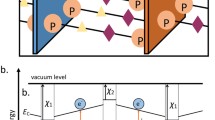Abstract
We report here the optical properties of near-transparent porous platinum films supported on p-type indium phosphide (InP). The deposition of small quantities of catalytically active metals on p-InP increases photoelectrochemical solar-to-hydrogen conversion efficiency by providing a pathway for photogenerated electrons to reduce efficiently protons in solution1. Surprisingly, efficiencies increase slowly even after fairly thick metallic layers have been deposited. These results imply that in certain conditions the metal overlayer is effectively transparent to the incident light, or even promotes the coupling of incident radiation into the bulk of the semiconductor2. We present here both experimental and theoretical evidence to show that these effects can be understood in terms of microstructure: when the metal films are sufficiently porous and built up from particles smaller than the wavelength of the transmitted light, the photon fields are screened out of the metal phase and are forced into the void structure. This increases the effective refractive index of the layer over that of the ambient and provides a better match with the substrate, while incurring negligible absorption loss.
Similar content being viewed by others
References
Heller, A., Aharon-Shalom, E., Bonner, W.A. & Miller, B. J. Am. chem. Soc. 104, 6942–6948 (1982).
Heller, A. Science 223, 1141–1148 (1984).
Albery, W. J. & Bartlett, P. N. J. electrochem. Soc. 130(8), 1699–1706 (1983).
Aspnes, D. E. & Studna, A. A. Appl. Opt. 14, 220–228 (1975).
Aspnes, D. E. & Studna, A. A. Appl. Phys. Lett. 39, 316–318 (1981).
Aspnes, D. E. & Studna, A. A. Phys. Rev. B 27, 985–1009 (1983).
Hale, G. M. & Query, M. R. Appl. Opt. 12, 555–563 (1973).
Aspnes, D. E., Theeten, J. B. & Hottier, F. Phys. Rev. B 20, 3292–3302 (1979).
Burggeman, D. A. G. Ann. Phys. (Leipzig) 24, 636–25, 679 (1935).
Maxwell Garnett, J. C. Phil. Trans. R. Soc. A 203, 385–420 (1904); 205, 237–288 (1906).
Author information
Authors and Affiliations
Rights and permissions
About this article
Cite this article
Porter, J., Heller, A. & Aspnes, D. Experiment and theory of ‘transparent’ metal films. Nature 313, 664–666 (1985). https://doi.org/10.1038/313664a0
Received:
Accepted:
Issue Date:
DOI: https://doi.org/10.1038/313664a0
- Springer Nature Limited
This article is cited by
-
Gas-chromism in ultrasonic spray pyrolyzed tungsten oxide thin films
Bulletin of Materials Science (2000)





